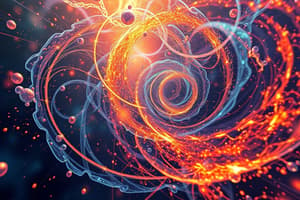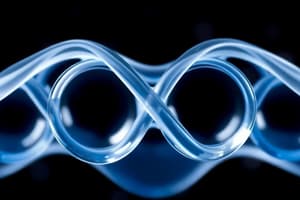Podcast
Questions and Answers
What is a characteristic behavior of gas particles according to the kinetic-molecular theory?
What is a characteristic behavior of gas particles according to the kinetic-molecular theory?
- Gas particles are attracted to one another strongly.
- Gas particles move freely and rapidly in all directions. (correct)
- Gas particles have a defined volume regardless of the container.
- Gas particles maintain a fixed position in a container.
Which statement is true about the behavior of gases when transferred to a larger volume?
Which statement is true about the behavior of gases when transferred to a larger volume?
- Gases remain the same size and do not expand.
- Gases condense when moved to a larger container.
- Gases will only occupy half the volume of the new container.
- Gases will expand to fill the new container completely. (correct)
Why are gases referred to as fluids?
Why are gases referred to as fluids?
- Gases retain their shape and volume in a container.
- Gases increase in volume significantly under high pressure.
- Gases can flow easily similar to liquids due to insignificant attractive forces. (correct)
- Gases are incompressible and cannot flow.
Under what conditions do many gases behave nearly ideally?
Under what conditions do many gases behave nearly ideally?
Which assumption of the kinetic-molecular theory relates to the flow of gas particles?
Which assumption of the kinetic-molecular theory relates to the flow of gas particles?
What does the kinetic-molecular theory suggest about the volume occupied by gases compared to liquids and solids?
What does the kinetic-molecular theory suggest about the volume occupied by gases compared to liquids and solids?
What characterizes an elastic collision according to the kinetic-molecular theory?
What characterizes an elastic collision according to the kinetic-molecular theory?
Which of the following statements best describes the distance between gas particles?
Which of the following statements best describes the distance between gas particles?
Why are gases considered easily compressible according to the kinetic-molecular theory?
Why are gases considered easily compressible according to the kinetic-molecular theory?
What is a primary difference between an ideal gas and a real gas?
What is a primary difference between an ideal gas and a real gas?
What causes real gases to deviate from ideal gas behavior?
What causes real gases to deviate from ideal gas behavior?
Under what conditions do real gases typically deviate the most from ideal behavior?
Under what conditions do real gases typically deviate the most from ideal behavior?
Which of the following gases is likely to behave most ideally under a range of conditions?
Which of the following gases is likely to behave most ideally under a range of conditions?
What factor influences the deviation of a gas from ideal behavior the most?
What factor influences the deviation of a gas from ideal behavior the most?
Which of the following gases is expected to show negligible deviation from ideal gas behavior?
Which of the following gases is expected to show negligible deviation from ideal gas behavior?
What is the primary reason gases have a low density compared to their solid or liquid states?
What is the primary reason gases have a low density compared to their solid or liquid states?
What happens to gas particles during compression?
What happens to gas particles during compression?
Which process describes the spontaneous mixing of gas particles?
Which process describes the spontaneous mixing of gas particles?
What distinguishes effusion from diffusion in gases?
What distinguishes effusion from diffusion in gases?
Which statement about gas behavior is correct?
Which statement about gas behavior is correct?
What characteristic distinguishes an ideal gas from a real gas in terms of molecular interaction?
What characteristic distinguishes an ideal gas from a real gas in terms of molecular interaction?
Which statement is true regarding the collisions of molecules in an ideal gas?
Which statement is true regarding the collisions of molecules in an ideal gas?
When comparing two gases at the same temperature, which gas will have the higher speed?
When comparing two gases at the same temperature, which gas will have the higher speed?
What phenomenon describes the spreading of a strong-smelling gas throughout a room after being released from a container?
What phenomenon describes the spreading of a strong-smelling gas throughout a room after being released from a container?
How does the speed of gas particles change when the gas is heated, under constant volume and pressure?
How does the speed of gas particles change when the gas is heated, under constant volume and pressure?
Which gas has the lowest rate of effusion among the following options?
Which gas has the lowest rate of effusion among the following options?
What primarily determines the rate of effusion of a gas?
What primarily determines the rate of effusion of a gas?
Why do polar gas molecules deviate more from ideal gas behavior than nonpolar molecules?
Why do polar gas molecules deviate more from ideal gas behavior than nonpolar molecules?
At higher temperatures, which of the following occurs to the molecular speed of gases?
At higher temperatures, which of the following occurs to the molecular speed of gases?
Where would two simultaneously injected gases mix first in a sealed tube?
Where would two simultaneously injected gases mix first in a sealed tube?
Flashcards are hidden until you start studying
Study Notes
Kinetic-Molecular Theory of Matter
- Explains constant motion of gas particles and their behavior.
- Provides a model for ideal gases, which perfectly meet theory assumptions.
Assumptions of Kinetic-Molecular Theory
- Large Particle Count: Gases contain numerous tiny particles that are widely spaced, resulting in mainly empty space, contributing to low density and compressibility.
- Elastic Collisions: Collisions between gas particles are elastic, conserving total kinetic energy when temperature is constant.
Properties of Gases
Expansion
- Gases lack a definite shape or volume and fill their containers entirely, adapting to their shape.
- Example: Gas expands from a one-liter vessel to a two-liter vessel.
Fluidity
- Minimal attractive forces between gas particles allow them to glide past one another, behaving like liquids.
Density and Compressibility
- Gaseous substances have a density about 1/1000 of their liquid or solid states due to particle spacing.
- Gases can be easily compressed; for example, gas cylinders may contain over 100 times the particles compared to nonpressurized containers of the same size.
Diffusion and Effusion
- Diffusion: Spontaneous mixing of gas particles occurs through random motion, e.g., ammonia mixing with air in a room.
- Effusion: Gas particles pass through tiny openings into a vacuum.
Real Gases vs. Ideal Gases
- Real gases deviate from ideal behavior due to particle attraction and volume.
- Conditions such as high pressure or low temperature lead to deviations; gases may condense into liquids under these circumstances.
- Noble gases (e.g., Helium, Neon) show near-ideal behavior due to minimal attraction between nonpolar monatomic particles.
- More polar gases (e.g., Ammonia, Water Vapor) exhibit greater deviations due to stronger attractive forces.
Key Terms
- Diffusion: Process of gas particles mixing spontaneously.
- Effusion: Movement of gas particles through tiny openings into a vacuum.
- Real Gas: Gas that doesn't fully adhere to kinetic-molecular theory assumptions.
Questions
- Ideal gases do not condense and have perfectly elastic collisions, while real gases experience intermolecular attractions.
- Kinetic energy remains constant during elastic collisions as long as temperature is unchanged.
- Lighter gases move faster than heavier gases if both have the same temperature.
- During effusion, lighter gases (e.g., He) effuse more quickly than heavier gases (e.g., Xe, Cl₂, HCl).
- Polar gases experience larger deviations from ideal behavior due to strong intermolecular attractions compared to nonpolar gases.
- When gases are injected simultaneously, mixing occurs closer to the center due to diffusion dynamics.
- Speed-distribution curves shift upward with increasing temperature, indicating higher molecular speeds.
Studying That Suits You
Use AI to generate personalized quizzes and flashcards to suit your learning preferences.




